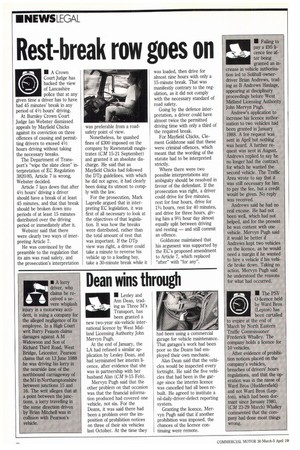Rest-break row goes on • A Crown Court Judge has
Page 22

If you've noticed an error in this article please click here to report it so we can fix it.
backed the view of Lancashire police that at any given time a driver has to have had 45 minutes' break in any period of 41/2 hours' driving.
At Burnley Crown Court Judge Ian Webster dismissed appeals by Mayfield Chicks against its conviction on three offences of causing and permitting drivers to exceed 41/2 hours driving without taking the necessary breaks.
The Department of Transport's "wipe the slate clean" interpretation of EC Regulation 3820/85, Article 7 is wrong, Webster decided.
Article 7 lays down that after 41/2 hours' driving a driver should have a break of at least 45 minutes, and that that break should be broken down into periods of at least 15 minutes distributed over the driving period or immediately after it.
Webster said that there were clearly two ways of interpreting Article 7.
He was convinced by the preamble to the regulation that its aim was road safety, and the prosecution's interpretation was preferable from a roadsafety point of view.
Nonetheless, he quashed fines of £300 imposed on the company by Rawtenstall magistrates (CM 15-21 September) and granted it an absolute discharge. He said that as Mayfield Chicks had followed the DTp guidelines, with which he did not agree, it had clearly been doing its utmost to comply with the law.
For the prosecution, Mark Laprelle argued that in interpreting EC legislation, it was first of all necessary to look at the objectives of that legislation. It was how the breaks were distributed, rather than the total amount of rest that was important. If the DTp view was right, a driver could take a minute to reverse his vehicle up to a loading bay, take a 30-minute break while it was loaded, then drive for almost nine hours with only a 15-minute break. That was manifestly contrary to the regulation, as it did not comply with the necessary standard of road safety.
Going by the defence interpretation, a driver could have almost twice the permitted driving time with only a third of the required break.
For Mayfield Chicks, Clement Goldstone said that these were criminal offences, which meant that the wording of the statute had to be interpreted strictly.
Where there were two possible interpretations any ambiguity should be resolved in favour of the defendant. If the prosecution was right, a driver could drive for five minutes, rest for four hours, drive for 13/4 hours, rest for 40 minutes, and drive for three hours, giving him a 9% hour day almost equally split between driving and resting — and still commit an offence.
Goldstone maintained that his argument was supported by the EC's proposed amendment to Article 7, which replaced "after" with "for any".








































































































































